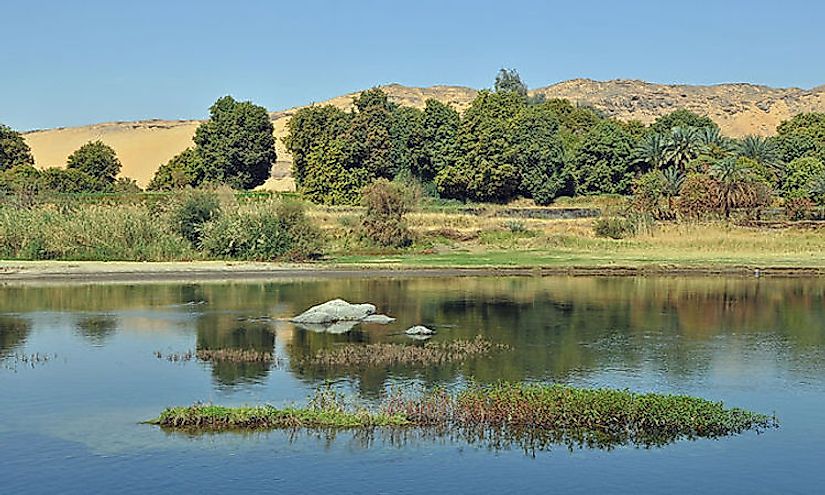Ecological Regions Of Egypt

Egypt is a country in the North Eastern corner of Africa. It covers an area of 386,660 square miles. Most of the country is covered by the Sahara and Libyan deserts. Interestingly, Egypt is home to the world’s longest river, the river Nile. The country is composed of a variety of ecological regions. Some of the ecological regions are Dry Sahel, Nile Delta, Levantine Sea, Sahara Desert, the Red Sea coastal desert and Mediterranean dry woodlands.
Ecological Regions Of Egypt
Dry Sahel
Dry Sahel is a afresh water biome and it is a transitional ecological zone that lies between the arid Sahara desert in the north and the humid Savannahs in the south. It is a semi-arid region covered by grasslands, savannahs, and thorny shrublands. The landscape is mostly flat with elevations of (200-400) meters above sea level. However, there are a few isolated areas that have elevations as high as 3000 meters. The region experiences limited rainfall in the summer months running from May to September. The rest of the year is a dry season. It has a tropical climate and has high temperatures throughout the year. Dry Sahel region once had an abundance of wildlife with animals such as the dama gazelle, red-fronted gazelle, giant buffalo, and the African wild dog inhabiting the area. Due to over-hunting, and competition for resources with other animals, the animal population in Sahel has significantly dropped. Some of the animals are extinct.
Levantine Sea
Levantine Sea ecological region is a marine biome and is the area that is Eastern most of the Mediterranean Sea. The Suez Canal which was completed in 1869 links the Levantine Sea to the Red Sea. Due to the higher elevation of the Red Sea compared to the Eastern Mediterranean Sea, water from the Red Sea pours into the Mediterranean Sea. For decades, plants and animals in the Red sea could not migrate to the Levantine Sea due to the very saline Bitter lakes that form part of the canal. However, as water flowed from the Red Sea to the Levantine Sea, the salinity of the water was neutralized. Plants and animals began to move from the Red Sea and into the Levantine Sea. River Nile brought freshwater and silt into the Levantine Sea and enabled the existence of Sardines in the area. When Aswan dam was constructed along the Nile, the flow of freshwater and silt into the Levantine Sea drastically dropped and led to the decline in sardine population. Consequently, the important sardine fisheries collapsed.
Sahara desert
Sahara desert region is one of the hottest areas in Egypt. The ecological zone is mostly rocky and has areas covered by sand dunes that are 180 meters high. The region is hyper-arid with very scarce vegetation. The area has clear skies and therefore experiences excessive heat from the sun. It has little or no rainfall throughout the year.
Nile Delta
Nile Delta ecoregion is found in Northern Egypt. The region is very fertile and suitable for agriculture. Nile Delta has an abundance of wildlife ranging from water birds to crocodiles, turtles to mongooses. Plants such as the Egyptian Lotus and Papyrus Sedge inhabit the region. The southern parts of Nile Delta experience hot desert climate while the northernmost parts experience moderate temperatures. Nile Delta is threatened by the rising water levels on the Mediterranean coast. Rising coast is a result of global warming. Construction of Aswan dam along the Nile led to fewer sediments flowing into the delta region and thus, the area is no longer as fertile as it was before the construction. Egyptian authorities need to take up steps to conserve the Nile Delta region before irreversible damage occurs.
Conclusion
Egypt is a nation with an abundance of ecological regions. The various ecological regions support different plants and animals. Climate experts have warned of severe consequences as a result of the Mediterranean Sea level rising. Conservation efforts, especially in the Nile Delta region, need to be increased so as to avert the looming danger.
Ecological Regions Of Egypt
| Ecological Regions of Egypt | Biome |
| Dry Sahel | Freshwater |
| Levantine Sea | Marine |
| Lower Nile | Freshwater |
| Mediterranean dry woodlands and steppe | Mediterranean Forests, Woodlands, and Scrub |
| Nile Delta | Freshwater |
| Nile Delta flooded savanna | Flooded Grasslands and Savannas |
| North Saharan steppe and woodlands | Deserts and Xeric Shrublands |
| Northern and Central Red Sea | Marine |
| Red Sea Coastal | Freshwater |
| Red Sea coastal desert | Deserts and Xeric Shrublands |
| Sahara desert | Deserts and Xeric Shrublands |
| Saharan halophytics | Flooded Grasslands and Savannas |
| South Saharan steppe and woodlands | Deserts and Xeric Shrublands |
| Temporary Maghreb | Freshwater |
| Tibesti-Jebel Uweinat montane xeric woodlands | Deserts and Xeric Shrublands |











